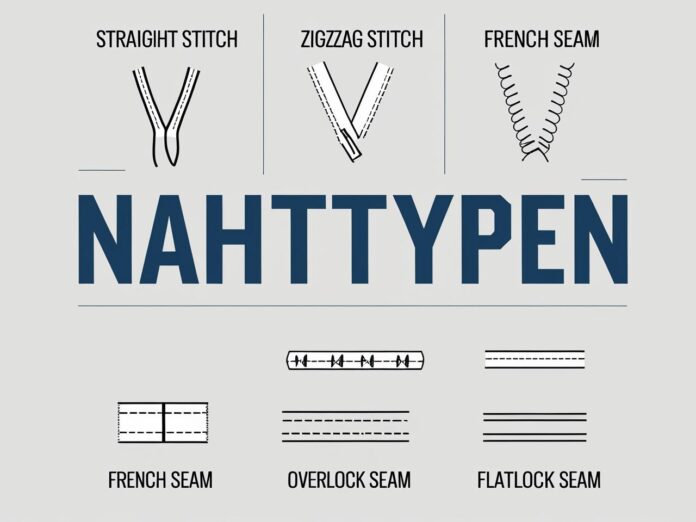Introduction: Why Understanding Nahttypen Is Essential for Sewing Success
When diving into sewing, one of the most important concepts to master is nahttypen, or seam types. These different seam styles determine not only the durability and fit of your garment but also its overall aesthetic. Whether you’re sewing casual wear, formal garments, or functional textiles, knowing the right nahttyp to use can transform your projects from amateur to professional quality.
This guide covers everything you need to know about nahttypen—their definitions, applications, and expert tips for sewing each one flawlessly.
What Are Nahttypen? The Foundations of Seam Construction
Nahttypen refer to the specific methods used to join fabric pieces by sewing. Choosing the appropriate seam type affects:
-
Strength: Seam durability during wear and washing.
-
Flexibility: How much the seam stretches or moves with the fabric.
-
Appearance: Clean, flat, or decorative finishes.
Understanding seam allowance, stitch types, and seam finishes is crucial before exploring different nahttypen.
Top 5 Essential Nahttypen Explained
1. Straight Stitch Seam (Gerade Naht)
This is the fundamental nahttyp used in nearly all sewing projects. A straight line of stitches connects two fabric pieces.
-
Best for: Woven fabrics, everyday clothing seams.
-
Benefits: Easy to sew, strong and reliable.
-
Pro tip: Maintain a consistent seam allowance (usually 1.5 cm) for optimal strength.
2. Zigzag Seam (Zickzacknaht)
The zigzag stitch is perfect for stretch fabrics or preventing edges from fraying.
-
Best for: Knit fabrics, stretch materials, edge finishes.
-
Benefits: Adds flexibility, secures raw edges.
-
Pro tip: Adjust stitch width based on fabric elasticity for maximum comfort.
3. Overlock Seam (Overlock-Naht)
Often created with serger machines, overlock seams trim, sew, and finish fabric edges in one step.
-
Best for: Ready-made clothing, activewear, knitwear.
-
Benefits: Professional finish, stretchable and durable.
-
Pro tip: Use thread tension settings matched to your fabric for neat seams.
4. French Seam (Französische Naht)
This nahttyp encloses raw edges, making it ideal for sheer or delicate fabrics.
-
Best for: Silk, chiffon, lightweight materials.
-
Benefits: Elegant, durable, hides raw edges completely.
-
Pro tip: Sew a narrow seam first, trim, then sew again right sides together for perfect finish.
5. Flatlock Seam (Kappnaht)
Flatlock seams lie flat against the skin and are used in garments requiring comfort and flexibility.
-
Best for: Sportswear, lingerie, casual wear.
-
Benefits: Minimal bulk, reduces skin irritation.
-
Pro tip: Requires specific flatlock stitch settings on coverstitch machines.
How to Choose the Perfect Nahttyp for Your Project
When selecting a nahttyp, consider:
-
Fabric type: Heavy fabrics like denim need sturdy seams; knits require flexible seams.
-
Seam function: Is the seam structural, decorative, or stretchable?
-
Appearance: Should seams be invisible, decorative, or flat?
-
Sewing method: Hand stitching vs. machine or serger sewing.
Expert Tips for Perfect Sewing of Nahttypen
-
Always test on scrap fabric to dial in machine settings.
-
Use appropriate needles and threads for your fabric weight.
-
Press seams after sewing to flatten and secure stitches.
-
Trim and finish seams properly to prevent fraying.
-
Maintain consistent seam allowance for professional results.
Avoiding Common Seam Mistakes
-
Skipping seam finishing leads to fabric fraying.
-
Uneven stitching affects seam strength and appearance.
-
Ignoring fabric stretch causes seam breakage.
-
Not pressing seams results in bulky, uneven fabric.
Frequently Asked Questions (FAQs) on Nahttypen
Q: Can I mix different seam types in one garment?
A: Yes! Mixing seams can enhance strength and style. For example, use straight seams for structure and overlock seams for edges.
Q: Which nahttyp is best for stretchy fabrics?
A: Overlock and zigzag seams are best suited for stretch fabrics.
Q: How can I make my seams last longer?
A: Use proper seam allowances, finish raw edges, and choose the right seam type for your fabric.
Conclusion: Mastering Nahttypen for Professional Sewing
Understanding and applying the right nahttypen ensures your sewing projects are durable, functional, and visually appealing. From simple straight seams to elegant French seams and flexible overlocks, each seam type has a role in creating high-quality textiles. With practice and attention to detail, you can confidently select and sew the perfect seam for any project.

